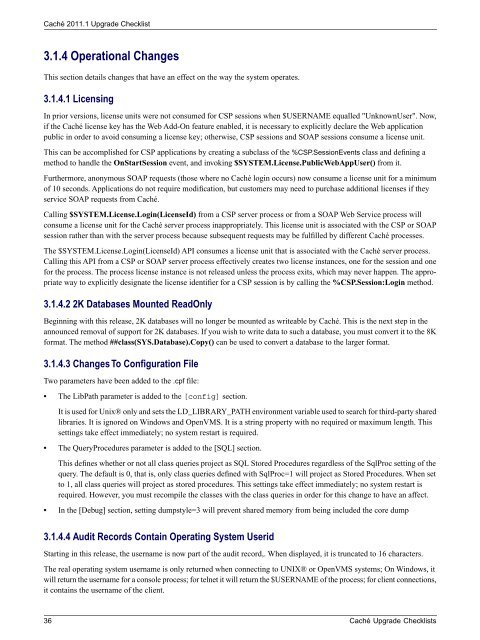Caché Upgrade Checklists - InterSystems Documentation
Caché Upgrade Checklists - InterSystems Documentation
Caché Upgrade Checklists - InterSystems Documentation
You also want an ePaper? Increase the reach of your titles
YUMPU automatically turns print PDFs into web optimized ePapers that Google loves.
<strong>Caché</strong> 2011.1 <strong>Upgrade</strong> Checklist3.1.4 Operational ChangesThis section details changes that have an effect on the way the system operates.3.1.4.1 LicensingIn prior versions, license units were not consumed for CSP sessions when $USERNAME equalled "UnknownUser". Now,if the <strong>Caché</strong> license key has the Web Add-On feature enabled, it is necessary to explicitly declare the Web applicationpublic in order to avoid consuming a license key; otherwise, CSP sessions and SOAP sessions consume a license unit.This can be accomplished for CSP applications by creating a subclass of the %CSP.SessionEvents class and defining amethod to handle the OnStartSession event, and invoking $SYSTEM.License.PublicWebAppUser() from it.Furthermore, anonymous SOAP requests (those where no <strong>Caché</strong> login occurs) now consume a license unit for a minimumof 10 seconds. Applications do not require modification, but customers may need to purchase additional licenses if theyservice SOAP requests from <strong>Caché</strong>.Calling $SYSTEM.License.Login(LicenseId) from a CSP server process or from a SOAP Web Service process willconsume a license unit for the <strong>Caché</strong> server process inappropriately. This license unit is associated with the CSP or SOAPsession rather than with the server process because subsequent requests may be fulfilled by different <strong>Caché</strong> processes.The $SYSTEM.License.Login(LicenseId) API consumes a license unit that is associated with the <strong>Caché</strong> server process.Calling this API from a CSP or SOAP server process effectively creates two license instances, one for the session and onefor the process. The process license instance is not released unless the process exits, which may never happen. The appropriateway to explicitly designate the license identifier for a CSP session is by calling the %CSP.Session:Login method.3.1.4.2 2K Databases Mounted ReadOnlyBeginning with this release, 2K databases will no longer be mounted as writeable by <strong>Caché</strong>. This is the next step in theannounced removal of support for 2K databases. If you wish to write data to such a database, you must convert it to the 8Kformat. The method ##class(SYS.Database).Copy() can be used to convert a database to the larger format.3.1.4.3 Changes To Configuration FileTwo parameters have been added to the .cpf file:• The LibPath parameter is added to the [config] section.It is used for Unix® only and sets the LD_LIBRARY_PATH environment variable used to search for third-party sharedlibraries. It is ignored on Windows and OpenVMS. It is a string property with no required or maximum length. Thissettings take effect immediately; no system restart is required.• The QueryProcedures parameter is added to the [SQL] section.This defines whether or not all class queries project as SQL Stored Procedures regardless of the SqlProc setting of thequery. The default is 0, that is, only class queries defined with SqlProc=1 will project as Stored Procedures. When setto 1, all class queries will project as stored procedures. This settings take effect immediately; no system restart isrequired. However, you must recompile the classes with the class queries in order for this change to have an affect.• In the [Debug] section, setting dumpstyle=3 will prevent shared memory from being included the core dump3.1.4.4 Audit Records Contain Operating System UseridStarting in this release, the username is now part of the audit record,. When displayed, it is truncated to 16 characters.The real operating system username is only returned when connecting to UNIX® or OpenVMS systems; On Windows, itwill return the username for a console process; for telnet it will return the $USERNAME of the process; for client connections,it contains the username of the client.36 <strong>Caché</strong> <strong>Upgrade</strong> <strong>Checklists</strong>
















